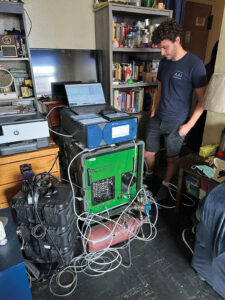When you talk stoves, people listen,” says the Stanford Ph.D. student
While not the most exciting topic for a Ph.D. research project, years of studying the ubiquitous household appliance as a graduate student at Stanford University revealed to Yannai Kashtan ’20 that gas stoves may be contributing to premature deaths and cases of childhood asthma.
A study co-authored with peers at Stanford and Oakland-based research institute PSE Healthy Energy was published in May, and Kashtan was featured in a subsequent Los Angeles Times story about the conclusions.
“I didn’t think the outside world would think [stoves] are that interesting,” the 25-year-old Oakland native says. “It’s not sexy. It’s not shooting rockets off into space. But [the interest] makes sense. This is something that affects one out of three people in the U.S. It makes sense people want to know about the dangers [stoves] pose.”

Kashtan inside his lab at Stanford
Over the course of their research, Kashtan and his peers at Stanford found that gas stovetops release a high level of pollutants—carbon monoxide, formaldehyde and benzene—that can inflame the lungs when inhaled.
Since at least the early 20th century, Kashtan says, the gas industry knew of the dangers of gas stove pollution, and yet over the years, stoves became the only unvented gas appliance in homes. As conscious as folks are about what is being cooked over the flame, Kashtan adds, they should be doubly conscious about the pollution from the flame itself.
The L.A. Times was the latest media outlet to feature the Pomona alumnus, whose research and comments have been published by national and international organizations such as CNN, Newsweek and The Guardian.
In a March profile in The New York Times, Kashtan advocated against fossil fuel companies funding climate research and solutions. The article called Kashtan a young climate researcher, a title he isn’t quite sure fits.
“I see myself both as an air quality scientist and a communicator,” the researcher says. “Someone who can try to bring science into policy and into, maybe, public perception as well. I like the idea of creating knowledge and putting it into action as much as possible.”
While at Pomona, Kashtan, a chemistry and physics double major, was remarkable in class and “simply outstanding in the research lab,” Janice Hudgings, Seeley W. Mudd Professor of Physics, wrote in a letter about her student.
Kashtan’s expertise in a lab comes as no surprise.
As a boy, Kashtan ran a YouTube channel under the handle “elementguy27.” From a homemade lab inside his parents’ garage, Kashtan explained dozens of elements from the periodic table—beryllium, cobalt, barium, selenium, among the 92 videos on the channel.
“As long as I can remember, I loved learning,” Kashtan says.
Beyond working at an advanced level in Hudgings’ lab at Pomona, Kashtan was “a terrific team player, always ready to jump in and help one of his peers,” Hudgings wrote.
Kashtan routinely volunteered as a teaching assistant and helped younger students with their homework “simply because it’s important to him that his peers succeed, too,” Hudgings added.
As a senior, Kashtan became the first Pomona student to be awarded the Knight-Hennessy scholarship—a full ride to Stanford to pursue the graduate program of his choosing. Knight-Hennessy scholars are thought to be “rebellious minds and independent spirits” and “future global leaders,” according to the criteria.
After being homeschooled through high school and being welcomed at Pomona, Kashtan speaks highly of the College’s faculty.
“At Pomona,” he says, “I was taught by lots of professors who were dedicated to their pedagogy, focused on teaching first, and had decades of experience, and that was a huge privilege. That focus on education and teaching, it’s not to be taken for granted.”
His Ph.D. research project complete, Kashtan plans to take a break from exploring gas stoves for the time being, though he intends to stay in a similar line of work in the future.
“I’m motivated by science itself,” he says, “but also wanting to make sure that science is then turned into action.”

